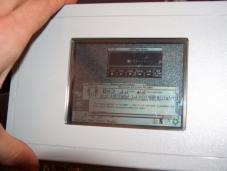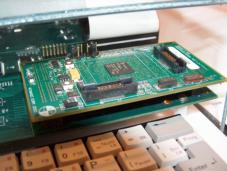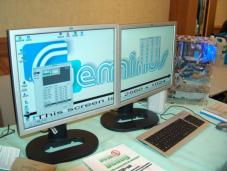



Iyonix Issues
Mark Rowan with our Iyonix column.
Two special offers for Christmas
Do It Yourself Iyonix makes a second appearance
The DIY Iyonix scheme has obviously been very popular with Castle because, for a second brief period between Dec 2nd - Dec 17th and at the same price of £729 inc. VAT + £15 delivery. The DIY kit allows users to buy a bare Iyonix motherboard and source their own components from other retailers, or by cannibalising old PCs, potentially saving hundreds of pounds.
The offer is again limited to two DIY kits per customer in order to keep Castle's support costs to a minimum.
January Sales
Castle announced a new addition to the Panther series of Iyonix PCs. It's a somewhat lower specification than the impressive Panther TC, having just one 40GB hard drive and 128MB RAM, compared to the the TC's 2x 120GB drives and 512MB RAM.In fact the new Panther is comparable to the standard low-end Iyonix PC and X111 desktop systems. The specifications are exactly the same, the only difference being the case the machines are housed in, and the price.
The new Panther is only £835 inc. VAT which is almost a third cheaper than the base level standard/desktop Iyonix PCs of the same specification. In fact, it's little over half the price of the Panther TC. One of the other Panther models is also reduced in price. The 120GB/512MB model, usually £1399, is now just £932.
More of the same, please
These sorts of price reductions are what I believe we need to keep seeing from Castle, particularly in the light of new alternative machines such as Apple's Mac Mini which is still a full 60% cheaper than the cheapest special offer Iyonix PC. Apple are hoping to attract huge numbers to their platform using their innovative design and making a radical change to their pricing structure (where a full blown Mac would cost about the same as some Iyonix PCs). With the price of Iyonix machines coming down, hopefully Castle can start to cause a similar stir rather than pricing potential buyers out of the market.Price comparison
Being the cynical type, I thought I'd have a look round and see if I could potentially build a DIY Iyonix for cheaper than buying a pre-built machine from Castle, especially in the light of the new special offers.
The following hardware prices are all inclusive of VAT but exclusive of delivery and handling charges. In no way is this a list of the absolute cheapest hardware available; you'll have to shop around yourself for that. And, even more importantly, this list is no guarantee of compatibility with the Iyonix. Castle make it very clear that there is a possibility some 'non-standard' devices will not work with the Iyonix motherboard, and they provide documentation with the DIY kit to help you choose suitable hardware.
The following DIY Iyonix is built to the low-end specification as used in the X111, the lowest-end Iyonix, and the new Panther. Prices are sourced from www.ebuyer.com but are subject to change.
| DIY Iyonix | |
| Motherboard | £729 |
| Belkin 5 port USB PCI card | £18.65 |
| Maxtor 40GB hard drive | £28.13 |
| Kingston 256MB 266MHz PC 2100 DDR RAM | £25.80 |
| LG CDRW drive | £16.44 |
| Sony floppy disc drive | £3.86 |
| Kingcase keyboard and mouse | £5.28 |
| Antec midi-ATX case | £33.30 |
| TOTAL: | £860.46 |
This is actually more expensive than the new low-end Panther in the sale and marginally cheaper than the higher-specification 120GB/512MB Panther, and doesn't even include delivery charges or your time to assemble the machine! So for a brand new Iyonix, it looks like you're currently not going to save "hundreds of pounds" by building your own using a DIY kit.
Of course, once the January sales are over and prices are back up to £1299 any future DIY Iyonix offers will represent a more handsome saving, but I would imagine anyone who bought a DIY kit in the December offer might have felt a sting in the tail when Castle announced the January sales!
End of prize draw
From Castle's website at www.iyonix.com it appears that Castle have finally ended their three-year prize draw competition to win an Iyonix, or cash to the value of your previously-purchased Iyonix. Which is a bit of a shame, as I was still rather hoping to get lucky. The prize draw link button has now been replaced with a link to the 'Special Offers' page detailing information about the machines mentioned earlier.
USB2 on the horizon
In an unusual break to form Castle have again pre-announced their USB2 drivers. They've already been demonstrated in some form or other at the Wakefield show in May 2004, but a recent post from Castle on the support mailing list confirms that the drivers are in final testing and are expected to be released during January.
The upgrade is likely to be a paid one, so let's hope that Castle can keep the price down on this one as USB2 can make a big difference when working with high-bandwidth USB devices such as memory card readers and it would be good to have drivers in the mass market so suitable device drivers can be written to take advantage of the extra features on offer.
At the same time as this announcement, Castle also made available another beta test of the USB1 and Mass Storage drivers which should hopefully result in many more devices being recognisable on the Iyonix's USB stack. As always, testing is done at the user's risk and any problems should be reported immediately to Castle - particularly as as-yet unsupported devices are most likely to freeze the machine due to the temporary removal of the device validity checks.
Trimming PreDesk
With all the ongoing public beta test software that Castle is releasing to users it's no surprise that redundant softloaded modules and support files are being left inside PreDesk once users install the official upgrades after testing. Paul Vigay has written a very detailed guide to cleaning up your Iyonix's PreDesk directory, available at http://www.vigay.com/riscos/system/index.html#ros5.Midlands Magic
At the Midlands RISC OS show in December Castle were demonstrating a very nice-looking piece of native RISC OS kit. They were showing off their port of RISC OS 5 to the NeoMagic MiMagic hardware running on an ARM9 processor core (ARM922T).
RISC OS running on a tiny screen at 320*256 resolution
The processor is clocked at 220MHz and the demonstration machine was plenty fast enough to use EasiWriter at the same time as playing an MP3 in AMPlayer, whilst leaving lots of CPU time for dragging windows around the desktop using the touchscreen. (The Software directory contains an MPEG video file - use KinoAmp on RISC OS to play).
The ARM9 processor used in the MiMagic is an embedded device with built-in support for data input/output and LCD monitor interfaces, aimed squarely at handheld gadgets such as PDAs. Castle wouldn't be drawn on whether or not we'd see a RISC OS PDA in the near future, but I was told that the cost of the development board which I saw in front of me was somewhere in the thousands of pounds so consumer models are unlikely to stem directly from current development in the near future!

The MiMagic board piggybacking on the development support board (which was used to provide keyboard input, power, etc)
Geminus looking good
At last I had a chance to see a working copy of Geminus, Neil Spellings and Adrian Lees' multi-monitor display driver for the Iyonix. Neil and Adrian are famous for their other major Iyonix projects, namely Aemulor and the <ahem> somewhat delayed Cino DVD software.

Geminus, with its nifty control panel allowing for easy configuration, looking very swish on a dual-monitor Iyonix
The software was working well and I was particularly impressed when Neil showed me his Iyonix playing a DVD in Cino full-screen on one monitor with a somewhat slow, but useable, desktop on the other monitor. The configuration application is very neat and allows a lot of customisation, including the ability to position the monitors in different places relative to each other - eg. one above the other, side by side, one or both rotated, etc.
There are still a few bugs to be ironed out but already Geminus is looking good. Witness the sample video of a window being dragged seamlessly from one monitor to the other (in the Software directory).
Mark Rowan iyonix@tamias.co.uk http://www.tamias.co.uk